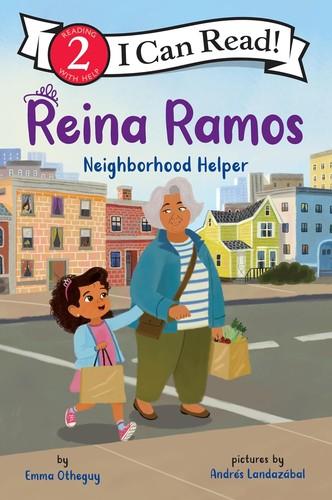Food relief
13 Reviews
(3)
K-3
I Can Read Book series.
Illustrated by
Andrés Landazábal.
In the latest installment of the Reina Ramos series, Reina is preoccupied with a food drive her school has turned into a competition: whichever class collects the most wins a pizza party. Reina tries to enlist Abuela's assistance, but Abuela is focused on bringing a homemade meal to their neighbor, who is caring for her new baby. The text includes multiple sentences per page and a sprinkling of Spanish words, complex sentences, and even the use of a colon, giving kids the opportunity to stretch their understanding of punctuation while also building their vocabularies. Sunny cartoon illustrations fill out Reina's world, depicting an active, warm, connected neighborhood and school. A glossary of Spanish words rounds out this appealing book.
Reviewer: Adrienne L. Pettinelli
| Horn Book Magazine Issue:
March, 2025
(2)
K-3
Illustrated by
Yazzie Johnson.
This informative picture book on the theme of "paying it forward" highlights the decades-long relationship between the Irish people and Indigenous communities in the United States. It opens with an acrylic painting of a young girl in a yellow dress running through a field of potato plants turning from healthy and green to wilted and brown. Readers learn that this is the start of the potato famine that plagued Ireland for five years beginning in 1845, during which millions of people died and two million immigrated to the United States, Britain, and Canada. When the Choctaw Nation, "still healing from their own hardships," heard of the Irish people's plight, they donated money to help send aid to Ireland. They felt like kindred spirits, or shilombish ittibachvffa, having lost lands and thousands of lives during the Trail of Tears from 1831–1834. Then in 2020, when COVID-19 threatened the Hopi and Navajo nations, the Irish people in turn sent aid. Yazzie's bold, vigorous illustrations reflect both the suffering and the strength of the afflicted communities. He also includes depictions of the Kindred Spirits statue the Irish government built to commemorate the support given by the Choctaw during the famine. Back matter provides greater detail about the Trail of Tears, the Great Famine, and the ongoing relationship between the Irish and the Choctaw.
Reviewer: Nicholl Denice Montgomery
| Horn Book Magazine Issue:
September, 2024
(3)
K-3
Illustrated by
Brizida Magro.
Mom tells Molly that they will visit a food pantry the next day, explaining, "Everybody needs help sometimes." While waiting in line, Molly spots her classmate Caitlin and is confused when Caitlin seems embarrassed to be there. As they put food in their cart, Molly's mom seems embarrassed, too, so Molly reminds her that it's okay to receive help. They leave with full grocery bags--and find a way to help others, as well. The book gently destigmatizes food insecurity without being preachy; soft illustrations show friendly shoppers and workers, making the pantry look like a welcoming place. A note for adults from the director of the Greater Chicago Food Depository puts fictional Molly's story in context.
Reviewer: Rachel L. Kerns
(4)
K-3
Illustrated by
Keum Jin Song.
In 2016, South Korean church members, originally refugees from North Korea, sent rice bags attached to helium balloons to North Korea to feed starving people. In this fictionalized story, a girl tries to convince other children who feel North Koreans are "the enemy" to join the effort. Slick digital illustrations contrast the lush South Korean countryside with barren North Korea. Includes extensive background material. Reading list.
Reviewer: Melinda Greenblatt
(3)
YA
Ten chapters urge readers to expand their food choices to help ameliorate the interrelated issues of climate change and global hunger. Suggestions--most already enjoyed by humans in many parts of the world--include protein-rich, sustainably raised insects (crickets, grubs); local wild plants and "weeds" (dandelions, kudzu); and invasive animal species (periwinkles, nutria). Full-color photos, recipes, nutritional charts, and "grow your own grubs" instructions are included. Reading list, websites. Bib., glos., ind.
Reviewer: Gail Hedges
(3)
K-3
Children in Our World series.
Illustrated by
Hanane Kai.
This compassionate exploration of poverty uses gentle, age-appropriate language. Kai's muted illustrations blend well with relatable explanations of how and why people end up suffering from hunger and poverty and the effect this has on families. The lucid text also discusses the ways in which charitable organizations provide aid and makes suggestions for how young readers can help. Reading list, websites. Glos., ind.
Reviewer: Kristy Pasquariello
(3)
YA
Maps, stock color photographs, and sidebars combine with a detail-rich text to present a comprehensive look at the world food crisis. Imbalances in access, quantity, and quality along with production, distribution, and ownership are fully explored; the influence of politics, technology, and climate on the food markets today and in the future are also addressed. Reading list, websites. Bib., glos., ind.
Reviewer: Tamara DePasquale
(4)
YA
Mapping Global Issues series.
This book examines poverty from a global perspective, defining the term and presenting possible solutions. Using an abundance of statistics, Senker compares countries where hunger is most severe with more prosperous regions and discusses various causes (e.g., debt, disease). Maps, sidebars, and photographs clarify and add interest to the text, but the dull layout is off-putting. Reading list, websites. Glos., ind.
Reviewer: Luther B. Clegg
(4)
YA
Voices series.
These titles explore some of the world's most pressing and difficult problems by offering a factual introduction to the complexities of the issues, how they arise, their effects, and the struggles involved in preventing, addressing, and resolving them. First-person accounts add emotional resonance to the charts, diagrams, statistic boxes, and photographs that crowd the pages. Reading list, timeline, websites. Glos., ind. Review covers these Voices titles: Hunger, War, Child Labor, Poverty, and Violence.
Reviewer: Cindy Lombardo
(4)
YA
World at Risk series.
This series explores a broad range of environmental issues, from climate change to conservation to waste disposal. Numerous photos, diagrams, and graphs add interest to the clearly worded scientific explanations. Social and political factors are covered as well, providing useful material for research and discussion. The content is somewhat repetitive across volumes, and the pages are a little crowded. Reading list, websites. Glos., ind. Review covers these World at Risk titles: Water, Feeding the World, Reducing the Carbon Footprint, Climate Change, Resources, and Waste Disposal.
Reviewer: Pamela Mishkin
(4)
4-6
Young Heroes series.
These biographies profile young adults who embody the spirit of community service, charity, and overcoming adversity. Most have founded their own charitable organizations, and all have won awards and recognition for their efforts. The writing is accessible, though it can be choppy. Photographs of the subjects at work clearly illustrate how kids can make a difference. Reading list, websites. Glos., ind. Review covers these Young Heroes titles: Brittany and Robbie Bergquist, Mattie Stepanek, Lindsey Williams, and Ana Dodson.
Reviewer: Hannah Rodgers Barnaby
(4)
4-6
In a Perfect World series.
Fridell thoroughly explores topics relating to world hunger, including poverty, repressive governments, debt, and human suffering. Color photos of malnourished children add context, but some of the book's maps are confusingly labeled, and Fridell presents his political opinions (e.g., the benefits of free trade) as facts. A section called "How You Can Help" appears toward book's end. Ind.
Reviewer: Anita L. Burkam
(4)
1-3
A Choctaw Indian tells a story from his boyhood. In 1847, living in poverty with their population greatly reduced, his people respond to the needs of the Irish during the potato famine by contributing $170 to the U.S. aid efforts. Based on a true event, the story is slightly romanticized but enhanced by pencil drawings with fine attention to detail.
Reviewer: Debbie Reese
13 reviews
We are currently offering this content for free. Sign up now to activate your personal profile, where you can save articles for future viewing.
















